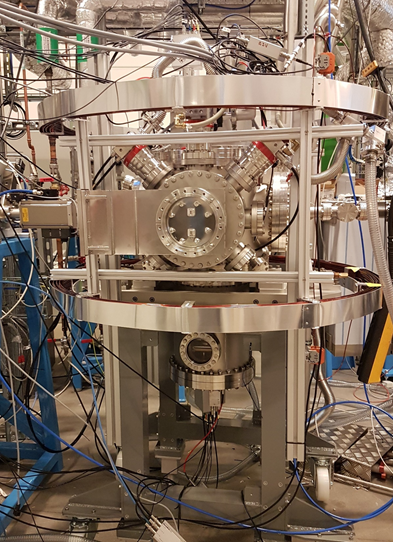The ICE (Ions in Coincidence with Electrons) end station is a mobile end station that is designed to be compatible with a number of MAX IV LDM-relevant beamlines. By using a combination of multi-coincidence and momentum imaging techniques along with the linearly/circularly/elliptically polarized soft x-rays delivered by the beamlines, it will be possible to investigate photo-induced reactions and to obtain kinematic information on specific dissociation channels of gas phase molecules and clusters – affording insight into the interplay between competing decay processes, the role of nuclear motion in a decay process, charge transfer processes and the relevant time-scales involved.

The ICE REMI (REaction MIcroscope) is available to general users.
Single-bunch operation: There will be a 1 week of single-bunch operation during the Fall Term 2023. When applying for a beamtime with single-bunch operation, indicate this clearly in your beamtime proposal. For more information please contact Noelle Walsh (noelle.walsh@maxiv.lu.se).
Experimental chamber
| Geometry & materials | CAMP – type vacuum chamber 316LN ESR stainless steel |
| Base pressure | 5⋅10-9-1⋅10-8mbar |
| Sample delivery systems | External: Molecular Jet/Cluster source (refer to 'LDM Sample Delivery Systems' for more information) |
| Beam size at sample (at FlexPES) | Defocused (h x v): up to 2 x 1.5 mm Focused (h x v): 75 x 15 μm; further reduction in size is possible with baffles (at the cost of flux) |
| Compatible beamlines | FlexPES (currently installed at FlexPES). Further possibilities: Veritas, FinEstBeAMS (please direct enquiries to N. Walsh) |
| ICE spectrometers | REMI: Reaction Microscope spectrometer (see below for further details) |
REMI spectrometer
| Max operating pressure | 1⋅10-6mbar |
| Description | RoentDek spectrometer Adjustable in length and electrostatic field geometry Maximum length: 1 m. Current length: 1m |
| Modes | COLTRIMS - Requires single-bunch delivery; - Static E-fields : a few V/cm - B-field (with Helmholtz coils, correction coils): see below Lens mode - Single Bunch/Multi-bunch mode; - Static E-fields : some 10’s V/cm - no B field |
| Magnetic Field | Helmholtz coils, Correction coils |
| Detectors | 2 x HEX 100 – 75 detectors (100 mm HEX delay lines and 75 mm MCP’s OAR 70%) |
| Electronics | 8-channel fast timing amplifier unit for detector signals, FAMP 8 fADC4/10-4: 10-bit flash ADC system for advanced multi-hit readout of HEX detectors (with PC via PCIe) and associated software |
| Software | Cobold PC TANGO for TIY scans etc |
| Data format | .lmf HDF5 xyt format ASCII |
| Compatible BL’s | FlexPES. Further possiblities: FinEstBeAMS, Veritas (please contact N. Walsh with enquiries) |